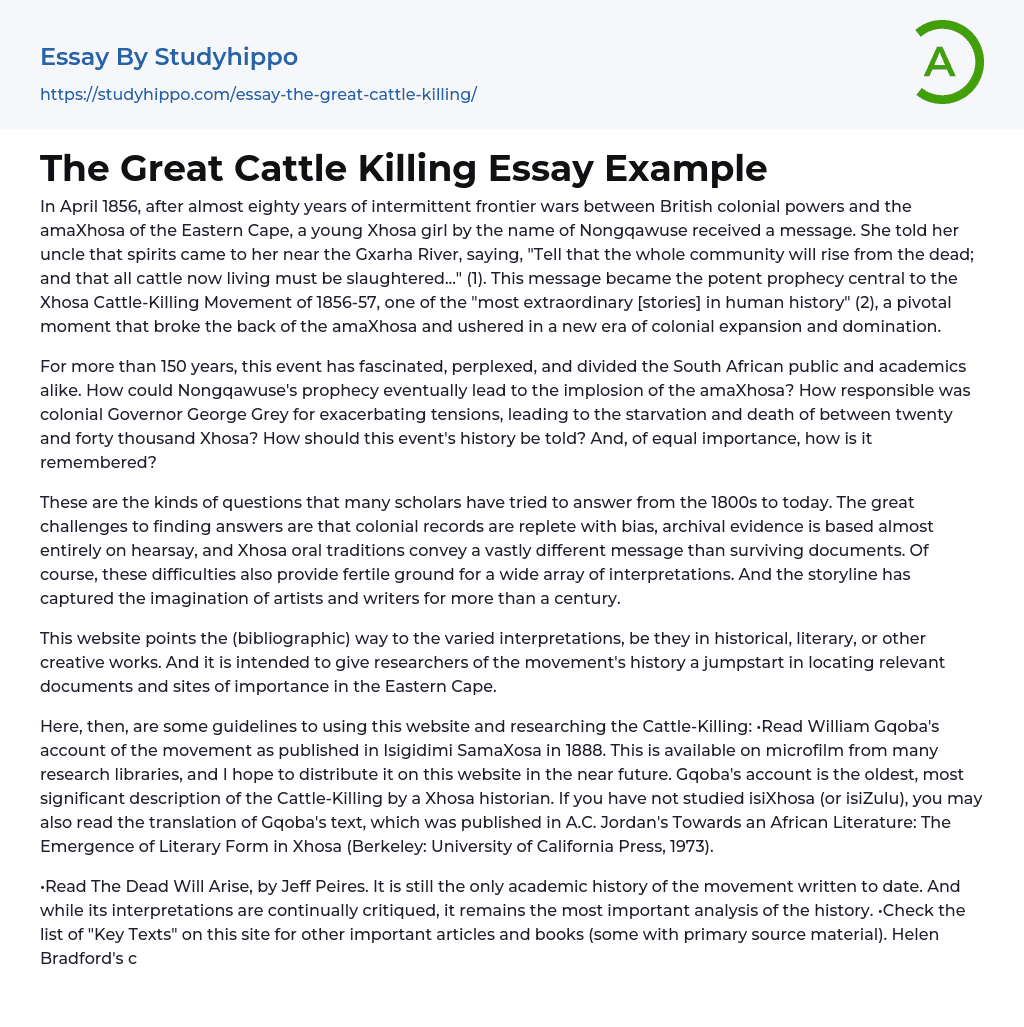In April 1856, after almost eighty years of intermittent frontier wars between British colonial powers and the amaXhosa of the Eastern Cape, a young Xhosa girl by the name of Nongqawuse received a message. She told her uncle that spirits came to her near the Gxarha River, saying, "Tell that the whole community will rise from the dead; and that all cattle now living must be slaughtered..." (1). This message became the potent prophecy central to the Xhosa Cattle-Killing Movement of 1856-57, one of the "most extraordinary [stories] in human history" (2), a pivotal moment that broke the back of the amaXhosa and ushered in a new era of colonial expansion and domination.
For more than 150 years, this event has fascinated, perplexed, and divided the South African public and academics alike. How could Nongqawuse's prophecy eventually lead to the implosion of the am
...aXhosa? How responsible was colonial Governor George Grey for exacerbating tensions, leading to the starvation and death of between twenty and forty thousand Xhosa? How should this event's history be told? And, of equal importance, how is it remembered?
These are the kinds of questions that many scholars have tried to answer from the 1800s to today. The great challenges to finding answers are that colonial records are replete with bias, archival evidence is based almost entirely on hearsay, and Xhosa oral traditions convey a vastly different message than surviving documents. Of course, these difficulties also provide fertile ground for a wide array of interpretations. And the storyline has captured the imagination of artists and writers for more than a century.
This website points the (bibliographic) way to the varied interpretations, be they in historical,
literary, or other creative works. And it is intended to give researchers of the movement's history a jumpstart in locating relevant documents and sites of importance in the Eastern Cape.
Here, then, are some guidelines to using this website and researching the Cattle-Killing: •Read William Gqoba's account of the movement as published in Isigidimi SamaXosa in 1888. This is available on microfilm from many research libraries, and I hope to distribute it on this website in the near future. Gqoba's account is the oldest, most significant description of the Cattle-Killing by a Xhosa historian. If you have not studied isiXhosa (or isiZulu), you may also read the translation of Gqoba's text, which was published in A.C. Jordan's Towards an African Literature: The Emergence of Literary Form in Xhosa (Berkeley: University of California Press, 1973).
•Read The Dead Will Arise, by Jeff Peires. It is still the only academic history of the movement written to date. And while its interpretations are continually critiqued, it remains the most important analysis of the history. •Check the list of "Key Texts" on this site for other important articles and books (some with primary source material). Helen Bradford's critiques of Peires's interpretations are particularly thought-provoking.
- Russian Empire essays
- Ancient Greece essays
- British Empire essays
- Historical Figures essays
- Nazi Germany essays
- Roman Empire essays
- War essays
- Revolution essays
- 19Th Century essays
- Historiography essays
- History of the United States essays
- 20Th Century essays
- World History essays
- Vikings essays
- Declaration of Independence essays
- Civilization essays
- Evidence essays
- Genocide essays
- Colonialism essays
- Rebellion essays
- 1960S essays
- 1920S essays
- 1950S essays
- Letter from Birmingham Jail essays
- Louisiana Purchase essays
- The Columbian Exchange essays
- World Hunger essays
- What is History essays
- Bravery essays
- Gilded Age essays
- Vladimir Lenin essays
- Alexander The Great essays
- Sparta essays
- Victorian Era essays
- Henry v essays
- Stonehenge essays
- Frederick Douglass essays
- Mahatma Gandhi essays
- Joseph Stalin essays
- Geert Hofstede essays
- George Eliot essays
- Ginevra King essays
- John Keats essays
- Siegfried Sassoon essays
- Ben jonson essays
- Billy elliot essays
- Wilkie collins essays
- John Proctor essays
- Harriet Tubman essays
- Napoleon essays




